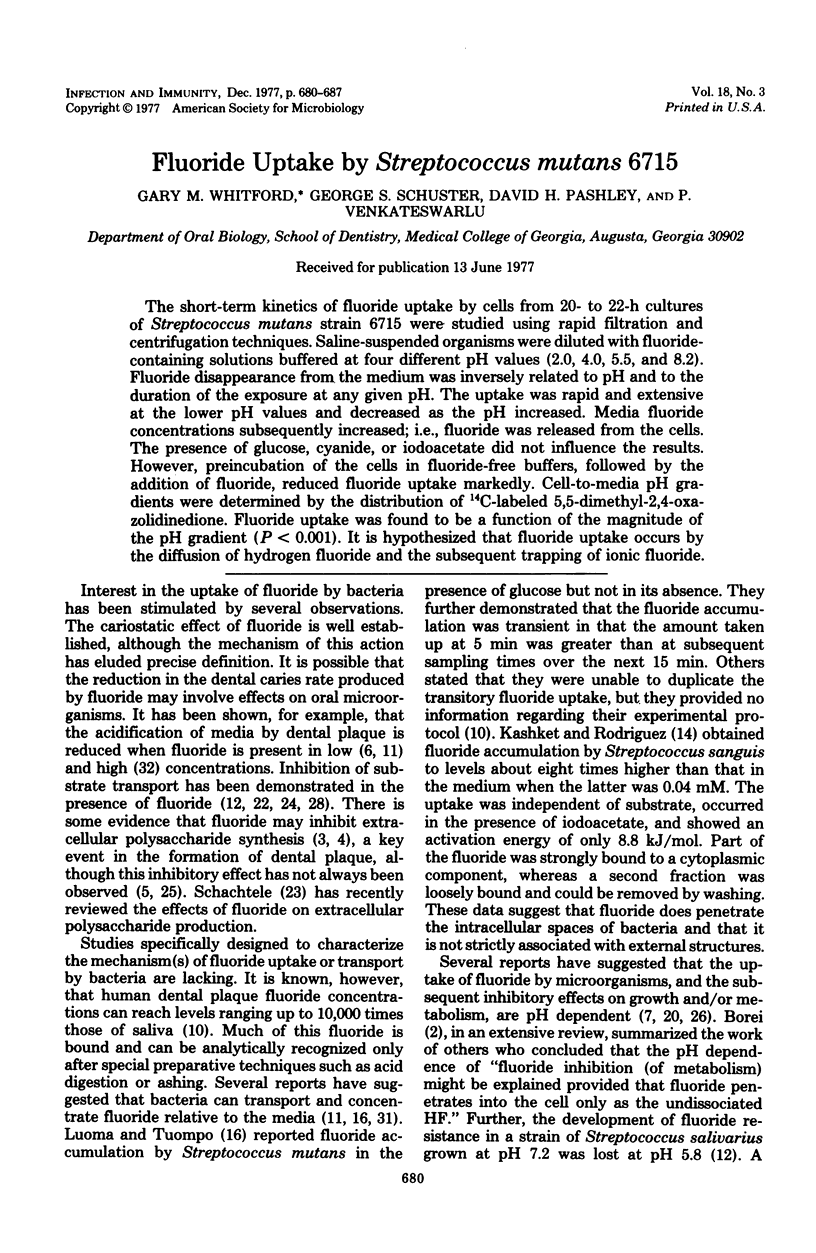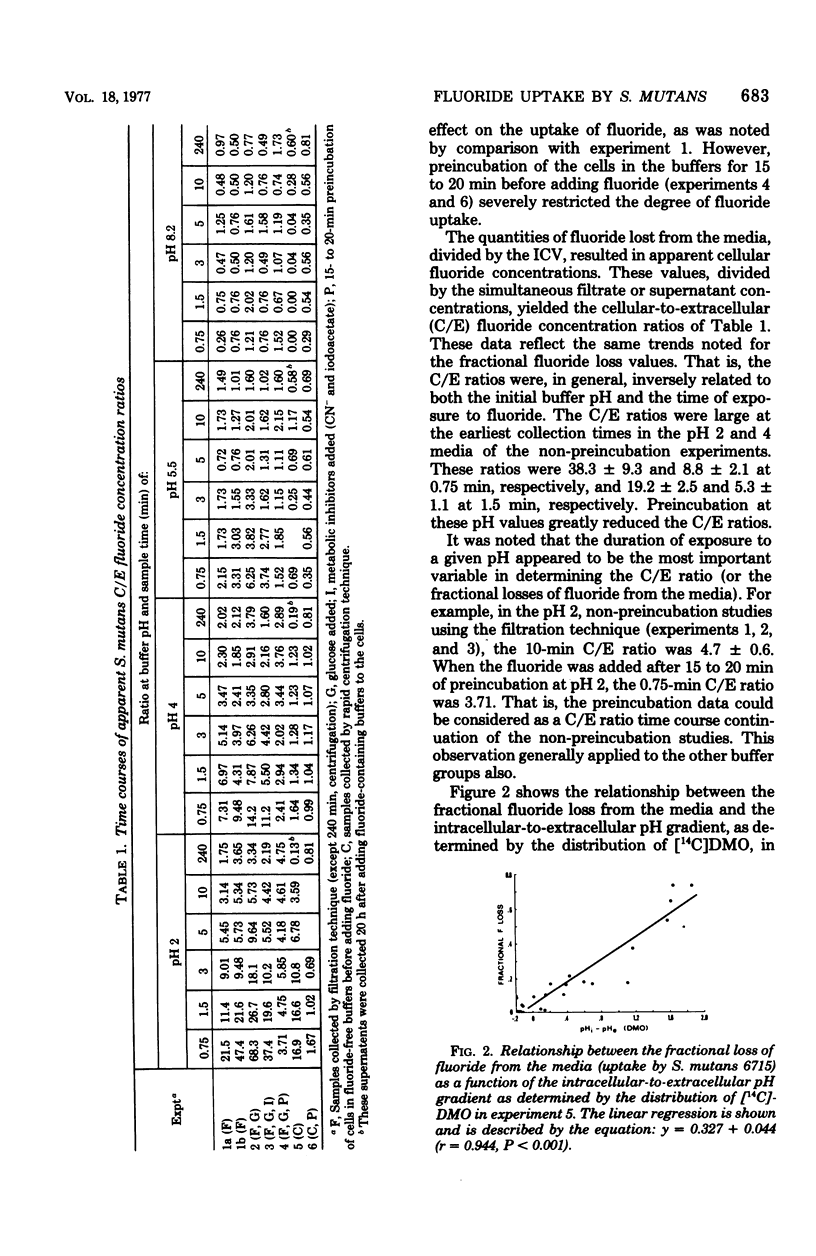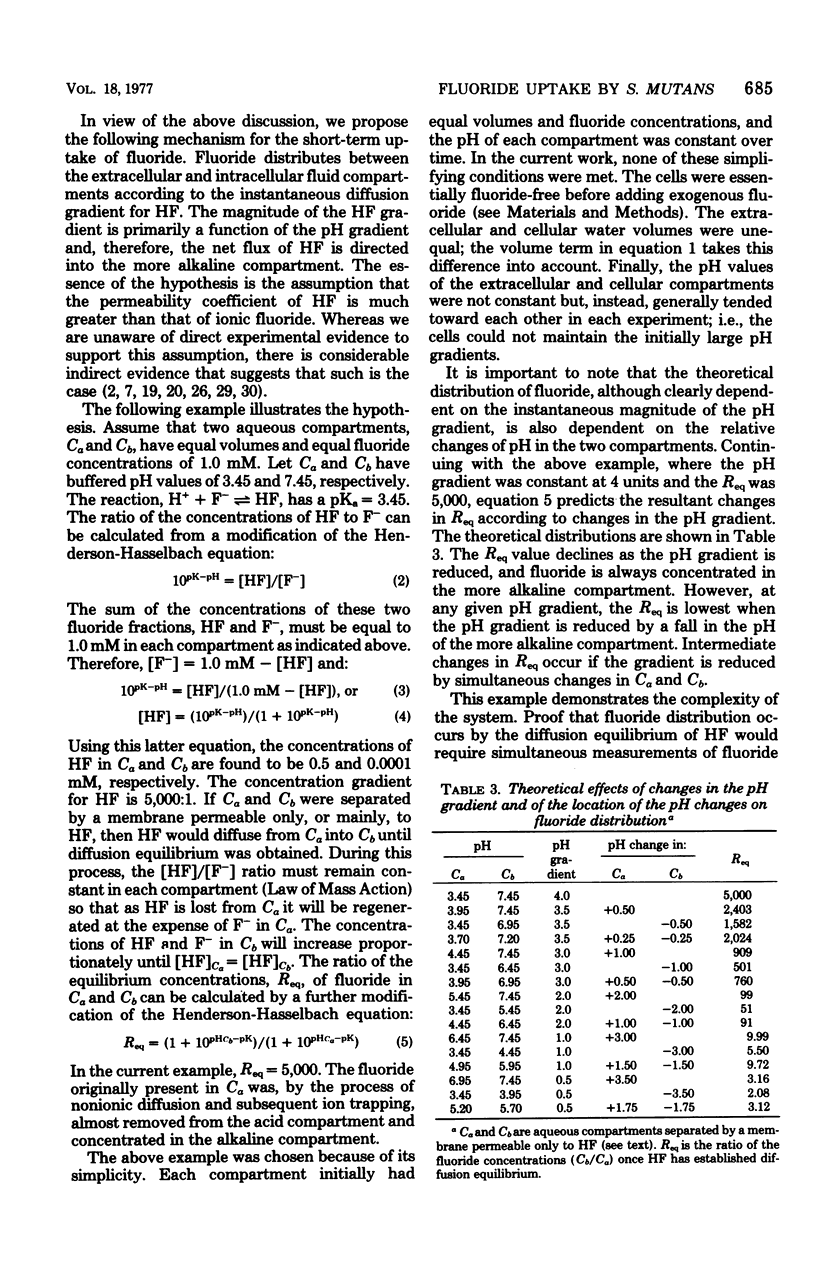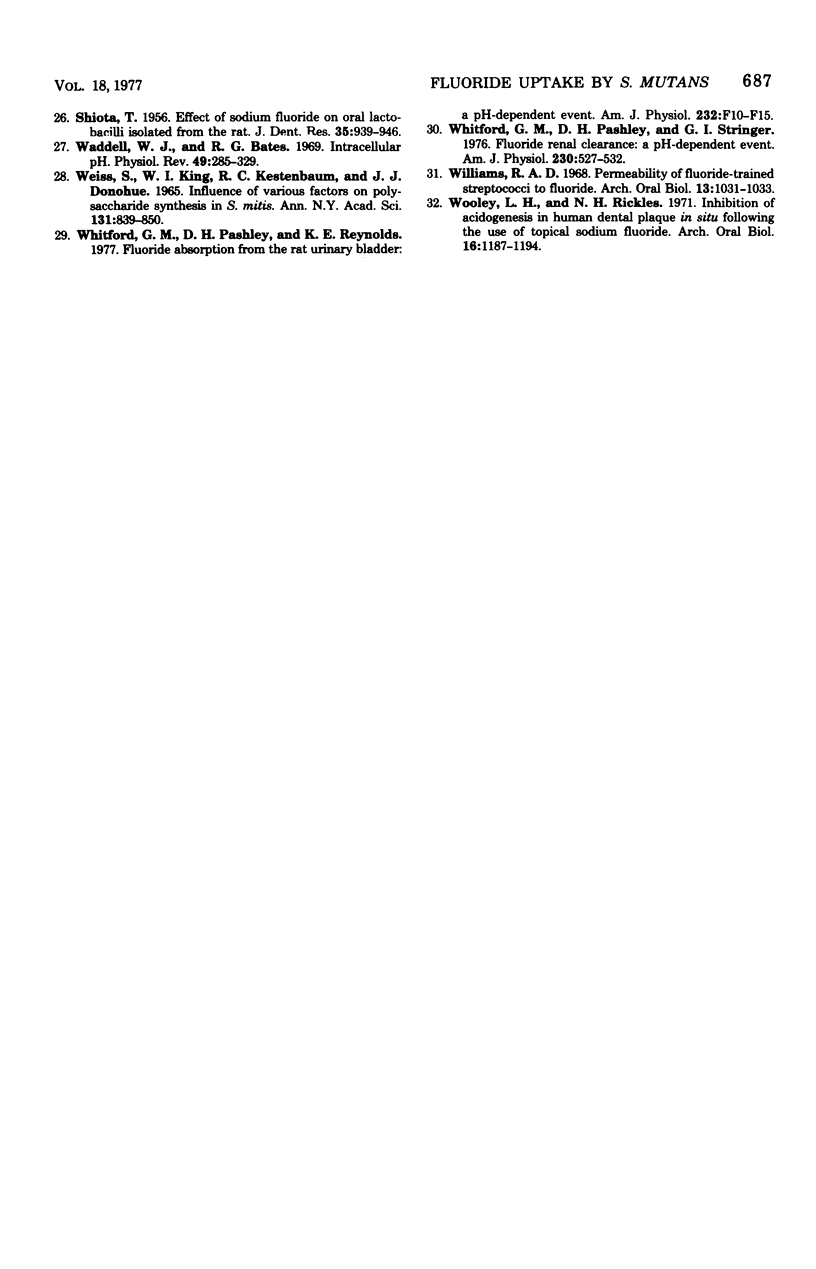Abstract
The short-term kinetics of fluoride uptake by cells from 20- to 22-h cultures of Streptococcus mutans strain 6715 were studied using rapid filtration and centrifugation techniques. Saline-suspended organisms were diluted with fluoride-containing solutions buffered at four different pH values (2.0, 4.0, 5.5, and 8.2). Fluoride disappearance from the medium was inversely related to pH and to the duration of the exposure at any given pH. The uptake was rapid and extensive at the lower pH values and decreased as the pH increased. Media fluoride concentrations subsequently increased; i.e., fluoride was released from the cells. The presence of glucose, cyanide, or iodoacetate did not influence the results. However, preincubation of the cells in fluoride-free buffers, followed by the addition of fluoride, reduced fluoride uptake markedly. Cell-to-media pH gradients were determined by the distribution of 14C-labeled 5,5-dimethyl-2,4-oxazolidinedione. Fluoride uptake was found to be a function of the magnitude of the pH gradient (P less than 0.001). It is hypothesized that fluoride uptake occurs by the diffusion of hydrogen fluoride and the subsequent trapping of ionic fluoride.
Full text
PDF







Selected References
These references are in PubMed. This may not be the complete list of references from this article.
- Birkeland J. M. Distribution of fluoride and a dilution indicator ( 51 Cr-EDTA) in bacterial suspensions. Scand J Dent Res. 1973;81(1):42–46. doi: 10.1111/j.1600-0722.1973.tb01493.x. [DOI] [PubMed] [Google Scholar]
- Broukal Z., Zajícek O. Amount and distribution of extracellular polysaccharides in dental microbial plaque. Caries Res. 1974;8(2):97–104. doi: 10.1159/000260097. [DOI] [PubMed] [Google Scholar]
- Carlsson J., Newbrun E., Krasse B. Purification and properties of dextransucrase from Streptococcus sanguis. Arch Oral Biol. 1969 May;14(5):469–478. doi: 10.1016/0003-9969(69)90140-x. [DOI] [PubMed] [Google Scholar]
- Edgar W. M., Jenkins G. N., Tatevossian A. The inhibitory action of fluoride on plaque bacteria. Furthr evidence. Br Dent J. 1970 Feb 3;128(3):129–132. doi: 10.1038/sj.bdj.4802436. [DOI] [PubMed] [Google Scholar]
- Gibbons R. J., van Houte J. On the formation of dental plaques. J Periodontol. 1973 Jun;44(6):347–360. doi: 10.1902/jop.1973.44.6.347. [DOI] [PubMed] [Google Scholar]
- Harold F. M., Pavlasová E., Baarda J. R. A transmembrane pH gradient in Streptococcus faecalis: origin, and dissipation by proton conductors and N,N'-dicyclohexylcarbodimide. Biochim Biophys Acta. 1970;196(2):235–244. doi: 10.1016/0005-2736(70)90011-8. [DOI] [PubMed] [Google Scholar]
- Hsung J. C., Haug A. Membrane potential of Thermoplasma acidophila. FEBS Lett. 1977 Jan 15;73(1):47–50. doi: 10.1016/0014-5793(77)80011-2. [DOI] [PubMed] [Google Scholar]
- Jenkins G. N., Edgar W. M. Distribution and forms of F in saliva and plaque. Caries Res. 1977;11 (Suppl 1):226–242. doi: 10.1159/000260302. [DOI] [PubMed] [Google Scholar]
- Jenkins G. N., Edgar W. M. The distribution and metabolic effects of human plaque fluorine. Arch Oral Biol. 1969 Jan;14(1):105–119. doi: 10.1016/0003-9969(69)90025-9. [DOI] [PubMed] [Google Scholar]
- Kanapka J. A., Khandelwal R. L., Hamilton I. R. Fluoride inhibition of glucose-6-P formation in Streptococcus salivarius: relation to glycogen synthesis and degradation. Arch Biochem Biophys. 1971 Jun;144(2):596–602. doi: 10.1016/0003-9861(71)90366-3. [DOI] [PubMed] [Google Scholar]
- Kashket E. R., Wong P. T. The intracellular pH of Escherichia coli. Biochim Biophys Acta. 1969 Oct 14;193(1):212–214. doi: 10.1016/0005-2736(69)90074-1. [DOI] [PubMed] [Google Scholar]
- Kashket S., Rodriguez V. M. Fluoride accumulation by a strain of human oral Streptococcus sanguis. Arch Oral Biol. 1976;21(8):459–464. doi: 10.1016/0003-9969(76)90103-5. [DOI] [PubMed] [Google Scholar]
- Luoma H., Tuompo H. The relationship between sugar metabolism and potassium translocation by caries-inducing streptococci and the inhibitory role of fluoride. Arch Oral Biol. 1975 Nov;20(11):749–755. doi: 10.1016/0003-9969(75)90047-3. [DOI] [PubMed] [Google Scholar]
- Maloney P. C., Wilson T. H. ATP synthesis driven by a protonmotive force in Streptococcus lactis. J Membr Biol. 1975;25(3-4):285–310. doi: 10.1007/BF01868580. [DOI] [PubMed] [Google Scholar]
- Marlow C. G., Sheppard G. Labelled tracers of inulin for physiological measurements. Clin Chim Acta. 1970 Jun;28(3):469–478. doi: 10.1016/0009-8981(70)90075-6. [DOI] [PubMed] [Google Scholar]
- Roberts M. H., Rahn O. Antisepsis and Ionization of Sodium Fluoride. J Bacteriol. 1946 Nov;52(5):612–613. [PMC free article] [PubMed] [Google Scholar]
- Rottenberg H. The driving force for proton(s) metabolites cotransport in bacterial cells. FEBS Lett. 1976 Jul 15;66(2):159–163. doi: 10.1016/0014-5793(76)80493-0. [DOI] [PubMed] [Google Scholar]
- SHIOTA T. Effect of sodium fluoride on oral Lactobacilli isolated from the rat. J Dent Res. 1956 Dec;35(6):939–946. doi: 10.1177/00220345560350061601. [DOI] [PubMed] [Google Scholar]
- Sandham H. J., Kleinberg I. The effect of fluoride on the interrelation between glucose utilization, pH and carbohydrate storage in a salivary sediment system. Arch Oral Biol. 1969 Jun;14(6):619–628. doi: 10.1016/0003-9969(69)90185-x. [DOI] [PubMed] [Google Scholar]
- Schachtele C. F., Mayo J. A. Phosphoenolpyruvate-dependent glucose transport in oral streptococci. J Dent Res. 1973 Nov-Dec;52(6):1209–1215. doi: 10.1177/00220345730520060801. [DOI] [PubMed] [Google Scholar]
- Sharma M., Dhillon A. S., Newbrun E. Cell-bound glucosyltransferase activity of Streptococcus sanguis strain 804. Arch Oral Biol. 1974 Nov;19(11):1063–1072. doi: 10.1016/0003-9969(74)90096-x. [DOI] [PubMed] [Google Scholar]
- Waddell W. J., Bates R. G. Intracellular pH. Physiol Rev. 1969 Apr;49(2):285–329. doi: 10.1152/physrev.1969.49.2.285. [DOI] [PubMed] [Google Scholar]
- Weiss S., King W. J., Kestenbaum R. C., Donohue J. J. Influence of various factors on polysaccharide synthesis in S. mitis. Ann N Y Acad Sci. 1965 Sep 30;131(2):839–850. doi: 10.1111/j.1749-6632.1965.tb34849.x. [DOI] [PubMed] [Google Scholar]
- Whitford G. M., Pashley D. H., Reynolds K. E. Fluoride absorption from the rat urinary bladder: a pH-dependent event. Am J Physiol. 1977 Jan;232(1):F10–F15. doi: 10.1152/ajprenal.1977.232.1.F10. [DOI] [PubMed] [Google Scholar]
- Whitford G. M., Pashley D. H., Stringer G. I. Fluoride renal clearance: a pH-dependent event. Am J Physiol. 1976 Feb;230(2):527–532. doi: 10.1152/ajplegacy.1976.230.2.527. [DOI] [PubMed] [Google Scholar]
- Williams R. A. Permeability of fluoride-trained streptococci to fluoride. Arch Oral Biol. 1968 Aug;13(8):1031–1033. doi: 10.1016/0003-9969(68)90020-4. [DOI] [PubMed] [Google Scholar]
- Woolley L. H., Rickles N. H. Inhibition of acidogenesis in human dental plaque in situ following the use of topical sodium fluoride. Arch Oral Biol. 1971 Oct;16(10):1187–1194. doi: 10.1016/0003-9969(71)90048-3. [DOI] [PubMed] [Google Scholar]


